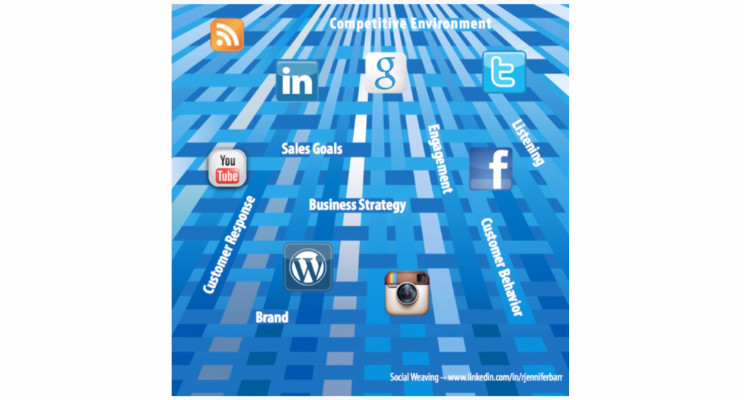
Digital Selling Through Integrated Social Weaving
As the digital marketplace becomes increasingly interactive, social and immediate, a successful content strategy needs to add several layers of planning to traditional sales and marketing. Since your customers utilize the same channels of communication designed to share and sell, your brand can be improved or tarnished in a short period of time by what is said about you online. By starting first from a strategic overview, you can optimize your selling techniques by using the right mix of digital “threads” to achieve your goals with the help of integrated social weaving.
Digital Selling is Like Weaving an Interactive Digital Tapestry
Some of the best examples of interwoven perspectives are the large medieval tapestries on display in European castles and churches. Up close, and from the back, they appear to be a multitude of different colored threads randomly held in place by knots. From the front and at a distance, however, you see a clear and compelling picture that tells an integrated story. This analogy especially holds true in the multi-threaded tapestry of online communications.
In the digital world, individual website content, blog posts, and social communications are the outgoing threads. Sales needs, business goals, and overall brand determine the picture you want to portray and, most importantly, where to place the threads.
So how does a company attract the most incoming digital “threads” to achieve the standard business goals of revenue, customer referrals, employee attraction and retention and industry respect?
Start with your business goals, brand and competitive environment as inputs and add customer behavior and responses as a variable component. Optimize your content and communication using multiple platforms, frequency, timing, type of content, tone, and a combination of organic and paid reach.
The Biggest Characteristic: Interactive
The planning process is made much more complex because our business tapestry is highly interactive – digital threads include customers, prospects, employees, thought leaders, competitors, and industry conditions, etc., which can come, go or even change color at any time, impacting all the threads around them.
Sales communications are no longer based on static elements like website content, white papers, emails and press releases. To reach and retain customers, additional interactive and receptive forms of communication are needed.
Three Tips for Forming an Integrated Digital Strategy
1. Start with your business strategy and brand, not your content
Deliver your product and sales messages in a larger brand story that, by design, includes and involves the customer. Many brands I observe use the “spaghetti approach” to sales and marketing communication. They throw a lot of content against the wall and hope some of it sticks. It doesn't matter how slick your graphics are or how many videos you embed, digital communication is most effective when it is done within a clear framework of your brand, values and business goals, alongside a clear understanding of your customer needs and preferences.
2. Communicate to attract customers, not sell product
Cultivating customers online helps to build loyalty and increase social sharing that can spread your story and influence purchase decisions. A strategic combination and placement of the following types of content can help meet sales goals while building relationships and brand.
- Broadcast content: This will be the majority of your content - traditional core sales and marketing communication showcasing product features and benefits. Use language that describes products as addressing customer needs, not just by their technical specifications.
- Attraction content: Draws customers to your brand and encourages social sharing. Talk about issues of interest to your customers besides your product. Examples include industry trends or helping the environment or a social issue.
- Connection content: Promotes opportunities for deeper engagement and builds long-term relationships and positive sentiment. Talk with your clients – answer their questions, respond to their concerns, ask for their input.
(also see my previous blog Sincerity: The Secret Sauce to Selling in the Digital Age)
3. Listen and receive instead of broadcast only
This is one of the main differences between using social media for PR and for social selling. The interactive and public nature of digital communications means brands have access to a literal wealth of information.
- Listen to your customers and prospects and learn their needs and preferences.
- Listen to industry thought leaders and follow industry hashtag streams on Twitter to learn about market trends.
- Watch your competitors, especially if what they’re doing works well. Use the information to be proactive in the marketplace.
For many businesses, especially B2B, even if you do follow this strategy, you will still likely need some paid advertising to grow your follower base and may only get a nominal response rate to online campaigns and surveys. Long-term relationship building is not measured by number of comments or shares alone. Over time, you demonstrate by your words and actions that you are a company who can deliver quality products and services while caring about your customers — through the art of digital social weaving.
.
#sales #marketing #digital #strategy #brand #socialmedia #Smm #mobile #video
(Opinions expressed here are my own and are not based on experience with any one organization. They do not necessarily reflect the opinions or practices of organizations for which I work or volunteer.)
Systems engineer, commercial energy storage at TotalEnergies
9yItem 3: Listening - accepting and seeking out feedback has to be the best power tool in that it creates better value and relationship on both sides. As a customer, I feel better if my feedback matters!